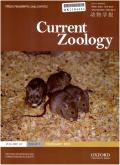Apennine-Pyrenees disjunct distribution: An unusual biogeographic pattern revealed in flea beetles of the Longitarsus candidulus species-group (Coleoptera, Chrysomelidae)
IF 2
2区 生物学
Q2 ZOOLOGY
引用次数: 0
Abstract
European mountain systems played a crucial role in shaping the distribution of species and of their genetic diversity during the Quaternary's climatic changes with the establishment of allopatric patterns across main mountain ranges. Here we investigated the evolutionary history of flea beetles of the Longitarsus candidulus species-group showing an uncommon disjunct biogeographic pattern across the Apennine and the Pyrenees. We applied a multilocus molecular approach and multispecies coalescent models to establish a phylogenetic and systematic framework for this morphologically homogeneous species-group and to estimate the time of main cladogenetic events underlying the origin of the Apennine-Pyrenees pattern. We found strong support for the monophyly of the candidulus group with a sister relationship between L. laureolae and L. leonardii endemic to the Apennine and the Pyrenees mountains respectively. The timing of speciation events in the candidulus species-group coincide with two major climatic transitions during Early and Middle Pleistocene that resulted in significant environmental changes in Europe and suggest a scenario of allopatric isolation and divergence on distinct mountain ranges. The split between the thermophilic species L. candidulus and the ancestor of the temperate species L. laureolae and L. leonardii, estimated at ~ 3 Ma during the transition from Pliocene to Pleistocene, was probably triggered by their segregation in xerophilous and temperate habitats. The speciation between L. laureolae and L. leonardii, ~ 1 Ma during the Mid-Pleistocene Transition, can be explained by the establishment of unfavorable conditions in West Alps and Central Massif underlying the onset of the Apennine-Pyrenees disjunct pattern. Finally, the strict association between members of the candidulus group and distinct Thymelaeaceae plants suggests further studies to address the hypothesis that speciation in these flea beetles might have been also associated with Pleistocene range changes of their host plants.亚平宁-比利牛斯的不连续分布:鞘翅目,蝶形目)的跳甲中发现的不寻常的生物地理格局
在第四纪气候变化期间,欧洲山脉系统在形成物种分布及其遗传多样性方面发挥了关键作用,在主要山脉之间建立了同域模式。在这里,我们研究了Longitarsus candidulus种群跳甲虫的进化史,该种群在亚平宁山脉和比利牛斯山脉之间呈现出一种不常见的不连续性生物地理格局。我们采用多焦点分子方法和多物种凝聚模型,为这一形态一致的物种群建立了一个系统发育和系统框架,并估计了亚平宁-比利牛斯模式起源的主要支系发生时间。我们发现,念珠菌群的单系性得到了强有力的支持,分别在亚平宁山脉和比利牛斯山脉特有的 L. laureolae 和 L. leonardii 之间存在姊妹关系。念珠树种群的物种分化事件发生的时间与早更新世和中更新世的两次重大气候转变相吻合,这两次气候转变导致欧洲环境发生了重大变化。嗜热物种L. candidulus与温带物种L. laureolae和L. leonardii的祖先之间的分裂估计发生在上新世向更新世过渡期间的约3Ma,可能是由它们在嗜湿和温带生境中的分离引发的。L.laureolae和L.leonardii之间的物种分化发生在中更新世过渡时期的约1Ma,这可以解释为在西阿尔卑斯山和中央丘陵地带不利条件的形成,是亚平宁-比利牛斯断层模式开始的基础。最后,念珠状甲虫类群成员与不同的百里香科植物之间的密切联系建议进一步研究这些跳甲虫的物种变异可能与其寄主植物的更新世范围变化有关的假说。
本文章由计算机程序翻译,如有差异,请以英文原文为准。
求助全文
约1分钟内获得全文
求助全文
来源期刊

Current Zoology
Agricultural and Biological Sciences-Animal Science and Zoology
CiteScore
3.20
自引率
9.10%
发文量
111
审稿时长
6 weeks
期刊介绍:
About the Journal
Current Zoology (formerly Acta Zoologica Sinica, founded in 1935) is an open access, bimonthly, peer-reviewed international journal of zoology. It publishes review articles and research papers in the fields of ecology, evolution and behaviour.
Current Zoology is sponsored by Institute of Zoology, Chinese Academy of Sciences, along with the China Zoological Society.
 求助内容:
求助内容: 应助结果提醒方式:
应助结果提醒方式:


